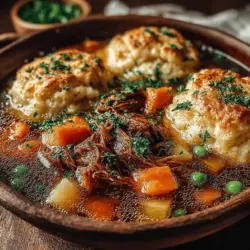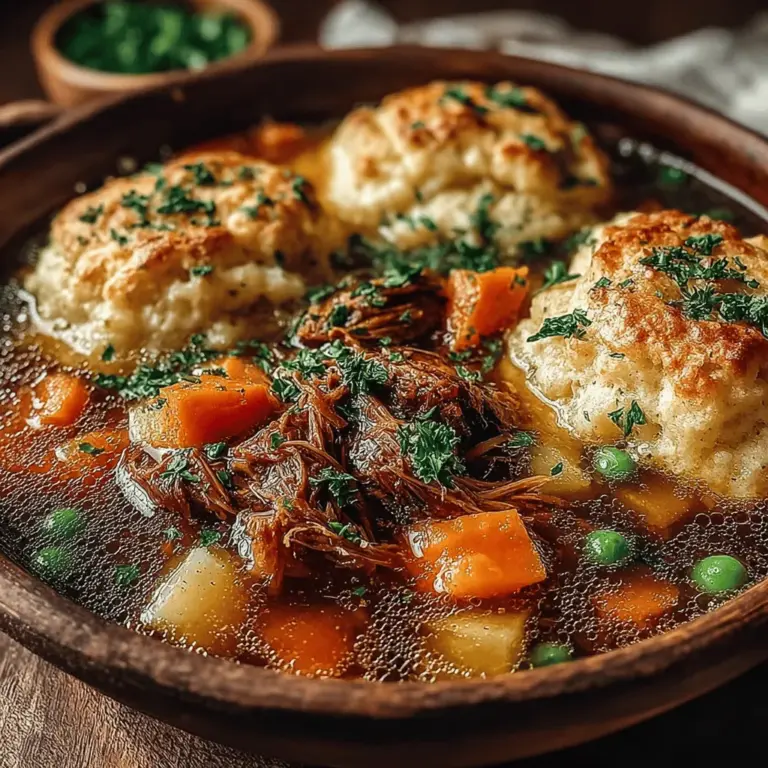Comforting Homestyle Chicken & Herb Dumplings: A Heartwarming Classic
When the chill of winter sets in or a rainy day calls for something cozy, few dishes deliver the warmth and comfort of a hearty bowl of chicken and herb dumplings. This beloved homestyle recipe is not only filling but also evokes a sense of nostalgia, reminding many of family gatherings and cozy evenings spent in the kitchen. The combination of tender chicken, savory vegetables, and fluffy herb dumplings creates a symphony of flavors and textures that make this dish a favorite for all ages.
Homestyle cooking holds a special place in our hearts, as it often draws on traditions passed down through generations. The act of gathering around the table, sharing stories, and enjoying a meal made with love is an essential part of family life. This chicken and herb dumplings recipe embodies that spirit, using simple, wholesome ingredients that transform into something truly special when cooked with care.
At its core, this recipe emphasizes accessibility, making it easy for anyone to prepare a comforting dish without requiring advanced cooking skills. With just a few key ingredients and straightforward techniques, you can create a meal that not only nourishes the body but also warms the soul.
Understanding the Ingredients
To create the perfect chicken and herb dumplings, understanding the ingredients is crucial. Each component contributes to the overall flavor and texture of the dish, ensuring a satisfying experience with every bite.
Key Ingredients in the Chicken Stew
The star of this comforting dish is undoubtedly the chicken. While many may opt for chicken breasts, chicken thighs are the preferred choice for this recipe. Thighs are inherently more flavorful and juicy, providing a tender texture that stands up beautifully during cooking. Their higher fat content ensures the meat remains moist, especially when simmered in a savory broth.
Alongside the chicken, a medley of vegetables enhances both the nutritional profile and taste of the stew. Carrots, celery, and onions form a classic mirepoix base, providing a depth of flavor that is essential in any hearty stew. These vegetables not only add sweetness and earthiness but also contribute vitamins and minerals, making the dish a well-rounded meal.
Herbs and spices play a pivotal role in elevating this homestyle dish. Fresh herbs such as thyme, rosemary, and parsley infuse the stew with aromatic qualities, while a pinch of salt and pepper helps to enhance the natural flavors of the ingredients. The combination of these herbs creates a fragrant backdrop that ties the dish together, making each spoonful a delightful experience.
Breaking Down the Herb Dumplings Ingredients
The dumplings are what truly make this dish stand out. Made with a blend of all-purpose flour, baking powder, baking soda, and buttermilk, they are the perfect accompaniment to the rich chicken stew. The baking powder and baking soda work in tandem to create a light and airy texture, ensuring the dumplings rise beautifully while retaining a tender bite.
Buttermilk is a key ingredient that contributes both flavor and texture to the dumplings. Its acidity reacts with the baking soda, resulting in a delightful rise and a slightly tangy flavor that complements the savory stew perfectly. In addition to buttermilk, a touch of fresh herbs—often the same ones used in the stew—adds a burst of flavor, making the dumplings a cohesive part of the dish.
Step-by-Step Preparation of the Chicken Stew
Now that we’ve covered the essential ingredients, let’s delve into the preparation of the chicken stew. This process begins with creating a flavorful base, which is crucial for building depth in the dish.
Preparing the Base: Sautéing Onions and Garlic
The first step in crafting your chicken stew is to sauté onions and garlic. Start by heating a generous drizzle of olive oil or a knob of butter in a large pot or Dutch oven over medium heat. The key to achieving the perfect sauté is to ensure your pot is hot enough before adding the onions. This helps to caramelize the onions, bringing out their natural sweetness and creating a rich foundation for the stew.
Once the oil is shimmering, add diced onions and minced garlic. Stir them frequently to prevent burning, allowing them to soften and develop a golden hue. This process usually takes about 5 to 7 minutes. The aroma that fills your kitchen during this step is nothing short of heavenly, as the onions and garlic meld together, setting the stage for the rest of the ingredients.
Building Flavor Through the Base Ingredients
After achieving the perfect sauté, it’s time to build on this flavor base. Add the chopped vegetables—carrots and celery—into the pot. These vegetables not only add texture but also infuse the dish with additional layers of flavor. Allow them to cook for a few minutes until they start to soften, stirring occasionally to ensure even cooking.
Once the vegetables are tender, it’s time to introduce the chicken. You can use bone-in thighs for added flavor or boneless thighs if you prefer a quicker cooking time. Browning the chicken before adding the broth is crucial for developing a rich, complex flavor. To do this, place the chicken pieces skin-side down in the pot, allowing them to sear for about 4 to 5 minutes until they are golden brown. This step also locks in the juices, ensuring the meat remains tender during the simmering process.
Incorporating the Broth and Seasonings
With the chicken browned and the vegetables softened, it’s time to incorporate the broth and seasonings. Pour in enough chicken broth to cover the ingredients, typically about 4 to 6 cups, depending on the size of your pot and the amount of chicken used. The broth will not only cook the chicken through but will also form the flavorful liquid that will ultimately turn into the stew.
Season the broth with salt, pepper, and your chosen herbs—fresh thyme and rosemary work beautifully here. Bring the mixture to a gentle simmer, allowing the flavors to meld together. The simmering process is vital for achieving a rich, flavorful stew, so be patient and allow it to cook for at least 30 minutes. During this time, you can taste and adjust the seasoning, ensuring the broth is well-balanced and suits your palate.
As the chicken and vegetables simmer, they release their flavors into the broth, creating a comforting and aromatic stew that’s sure to warm you inside and out. The anticipation builds as you prepare to take this dish to the next level with the herb dumplings.
Crafting the Herb Dumplings
While the stew simmers, you can turn your attention to crafting the herb dumplings. Begin by mixing the dry ingredients—flour, baking powder, baking soda, and a pinch of salt—in a mixing bowl. This ensures an even distribution of the leavening agents, which is key to achieving light, fluffy dumplings.
In a separate bowl, combine the wet ingredients: buttermilk and melted butter. Whisk them together until they are well blended. Then, pour the wet mixture into the dry ingredients, stirring gently until just combined. Overmixing can lead to dense dumplings, so it’s important to stop as soon as no dry flour remains.
Next, fold in the fresh herbs you’ve chosen for the dumplings. This step not only adds flavor but also ties the dumplings to the stew, creating a harmonious dish. The dough should be slightly sticky but manageable. If it feels too wet, you can sprinkle in a bit more flour until it reaches the desired consistency.
With the dumpling dough ready, it’s time to prepare for the final assembly, where the comforting elements of chicken and herb dumplings will come together in a warm embrace.
This homestyle chicken and herb dumplings recipe is a celebration of flavors, textures, and the love that goes into cooking. As you embark on this culinary journey, you’ll find that the process is just as rewarding as the final dish, creating not just a meal, but cherished memories in the kitchen.
{{image_2}}
Importance of Measuring Accurately for Best Results
When it comes to making dumplings, accuracy in measuring ingredients is paramount. Unlike other cooking methods where a bit of improvisation can yield delicious results, dumplings require precise measurements to achieve the ideal texture and flavor. Too much flour can lead to dense dumplings, while too little can cause them to fall apart. Utilizing a kitchen scale for dry ingredients and measuring cups for liquids ensures that you achieve the right balance.
Techniques for Combining Ingredients Without Overmixing
Dumplings thrive on a light touch. To combine the ingredients effectively, start by whisking your dry ingredients separately before adding them to the wet mixture. Once combined, use a spatula or wooden spoon to fold the ingredients together gently. Overmixing can lead to tough, chewy dumplings, which are far from the tender texture we desire. Aim for a few lumps in the mixture; this is a sign of a well-made dumpling batter.
Achieving the Right Consistency for Dumplings
The consistency of your dumpling batter is crucial. It should be thick enough to hold its shape but not so dense that it becomes a heavy mass. A good rule of thumb is to ensure that the batter can hold a shape when dropped from a spoon but still flows slightly. If your batter is too thick, add a tablespoon of milk or broth at a time until you reach the desired consistency.
Visual Cues for the Perfect Dumpling Batter
The perfect dumpling batter has a slightly sticky texture but holds together. When you scoop it with a spoon, it should mound up without collapsing immediately. The surface of the batter should appear smooth but not perfectly uniform; small lumps are acceptable. If you find that the batter is too soupy, it indicates that you may need to incorporate more flour.
Common Mistakes to Avoid When Preparing Dumplings
1. Overmixing the batter: As previously mentioned, overmixing leads to tough dumplings. Always mix just until combined.
2. Incorrect ingredient ratios: Make sure to follow the recipe closely, particularly with flour and liquid measurements.
3. Neglecting resting time: Allowing the batter to rest for about 10 minutes can help the flour hydrate and improve texture.
4. Starting with boiling stew: Dumplings should be placed onto simmering stew rather than boiling to ensure they cook evenly without becoming rubbery.
Integrating Dumplings into the Stew
Techniques for Dropping Dumplings onto the Stew
Once your stew is at a gentle simmer, it’s time to integrate the dumplings. Use a spoon or an ice cream scoop to drop portions of the batter directly onto the surface of the stew. This method allows the dumplings to maintain their shape while floating on the broth.
Tips for Spacing and Ensuring Even Cooking
Space the dumplings about an inch apart to allow for expansion during cooking. Crowding them can lead to uneven cooking. If you are unsure of how many to add, start with fewer dumplings and gauge the cooking time before adding more.
Importance of Maintaining Covered Cooking for Steam Efficiency
Covering the pot while the dumplings cook is essential. The steam generated under the lid helps the dumplings rise and cook through evenly. It also prevents the broth from evaporating too quickly, ensuring that your stew remains rich and flavorful.
Understanding Cooking Time for Dumplings
Dumplings typically require about 15 to 20 minutes to cook through. The key is to avoid lifting the lid too frequently, as this can disrupt the cooking process. Set a timer and check for doneness towards the end of the cooking time.
How to Tell When Dumplings Are Fully Cooked
To check if dumplings are cooked, look for visual cues: they should have expanded in size and appear fluffy. You can also insert a toothpick or knife into the center of a dumpling; if it comes out clean, the dumpling is done.
Serving Suggestions and Presentation
Best Practices for Serving Chicken and Dumplings
Serving chicken and dumplings is an art in itself. Use shallow bowls to showcase the dumplings and broth, allowing the rich colors and textures to shine.
Ideal Bowl Types and Garnishing Tips
Opt for wide, shallow bowls that allow the dumplings to be the star of the show. For garnishing, fresh herbs like parsley or thyme can add a pop of color and freshness. A sprinkle of freshly ground black pepper or a dash of paprika can also enhance visual appeal.
Suggestions for Pairing with Sides like Crusty Bread or Salad
For a complete meal, consider pairing your chicken and dumplings with a side of crusty bread for dipping or a light salad to balance the richness of the stew. A simple green salad with a tangy vinaigrette can provide a refreshing contrast.
Creating an Inviting Presentation with Visual Appeal
Presentation plays a vital role in making your dish appealing. Layer the dumplings and chicken attractively in the bowl, ensuring that the broth is visible. Use colorful garnishes and consider adding a wedge of lemon on the side for a bright touch.
Importance of Color Contrast and Freshness in Presentation
Color contrast elevates the visual appeal of your dish. Bright green herbs against the golden broth and fluffy dumplings create an inviting plate. Freshness is equally important; serve immediately after cooking to maintain the inviting aroma and warmth.
Nutritional Value and Health Benefits
Overview of the Nutritional Content of the Dish
Chicken and dumplings offer a well-rounded meal, combining protein, carbohydrates, and essential vitamins and minerals. The chicken provides lean protein, while the vegetables contribute fiber and nutrients.
Benefits of Chicken and Vegetables as a Protein Source
Chicken is an excellent source of protein, which is vital for muscle repair and growth. The inclusion of vegetables not only boosts the nutritional content but also adds fiber, aiding digestion and providing a sense of fullness.
The Role of Herbs in Promoting Health and Flavor
Herbs are not just for flavor; they also come packed with health benefits. For instance, thyme has antibacterial properties, while parsley is rich in vitamins A, C, and K. Incorporating herbs into your cooking not only enhances taste but also contributes to your overall well-being.
Conclusion
In summary, this comforting homestyle chicken and herb dumplings recipe is a delightful dish that brings warmth and satisfaction to the table. The ease of preparation, along with the rich, hearty flavors, makes it a perfect choice for family gatherings or a cozy weeknight dinner. Sharing a homemade meal like this fosters connections and creates lasting memories around the dinner table.
As you become familiar with this recipe, don’t hesitate to explore variations. Consider adding seasonal vegetables, experimenting with different herbs, or even trying alternative flours for the dumplings. This dish is a canvas for your creativity, allowing you to customize it to suit your taste preferences. Enjoy the comfort and joy that comes from cooking and sharing this delightful meal with your loved ones.


